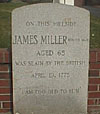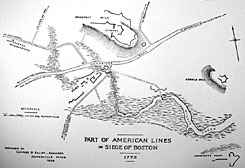
Before the American Revolution made it famous, Prospect Hill was part of a dairy farm on the quiet, rural outskirts of Boston. Early on it was called Strawberry Hill and Wildredge's Hill, and in the 17th century was part of the estate of John Woolrych. The land now called Somerville was once part of Charlestown and often referred to as "beyond the Neck" of the more populated Charlestown peninsula. Much of Somerville was used for farming, cattle raising, quarrying, and brick making.
This peaceful chapter of history ended on April 18, 1775. In the quiet of the night, British soldiers crossed the Charles River from Boston and marched past Prospect Hill on the way to Concord. There, they destroyed military stores kept there by the increasingly rebellious colonists. The "shot heard round the world" soon became many shots as the British retreated the next day through Lexington under steady fire from local farmers.

Map of the British retreat from Concord (enlarge)
When they passed Prospect Hill again, another skirmish broke out near present-day Union Square. When it was clear the colonists were outgunned, they all retreated except 65-year-old James Miller, who said, "I am too old to run." He kept fighting until he was killed.
Finally, the British reached Bunker Hill and the chase ended. Militia officers met at the foot of Prospect Hill and posted sentinels to keep an eye on the British as they crossed the river back into Boston.
The seige of Boston had begun.
Within a few days, a Colonial army of 16,000 men surrounded Boston with a line of entrenchments stretching from Roxbury to Chelsea. Earthworks were built near Union Square at the foot of the hill, along with many other locations around the city. By June, General Gage declared martial law in Boston and expanded British forces to 10,000. Realizing the importance of higher ground, Gage made plans to seize and fortify hills in Dorchester Heights and Charlestown.
Fortunately, the colonists found out about these plans. In the early morning hours of June 17, militiamen quietly began fortifying Breeds Hill in Charlestown. The British were shocked to see the fortifications at dawn, and the Battle of Bunker Hill began as the British fought to drive the colonists out of Charlestown. The colonists withstood the attack for some time before running out of ammunition and retreating back across the Neck into present-day Somerville.
Many colonists were killed in the retreat, but the army continued to Prospect Hill and, under the orders of General Israel Putnam, immediately began building camps and fortifications. Prospect Hill provided a commanding view of Boston, the British fleet at anchor, and the surrounding countryside, and for the next few days the British tried to drive the colonists off the hill. But as more colonists joined the army and as fortifications grew, Prospect Hill became known as the "Citadel," the strongest fortification in the frontline of the American Revolution.
From the diary of a soldier, Caleb Haskell...
June 18: "The enemy kept up a continual firing upon us at Prospect Hill, which we were fortifying. At 9 o'clock in the evening received orders to go down to the hill, march to headquarters. Received new orders to go back to our quarters and hold ourselves in readiness."
June 19: "The daylight comes on with the noise of cannon from Bunker's Hill and floating batteries discharging at us on Prospect Hill which continues all day. The enemy set the upper end of Charlestown on fire. We mounted picket guard."
June 21: "Pleasant weather. We continued entrenching on Prospect Hill without disturbance."
Because of its prominence, the British referred to Prospect Hill as "Mount Pisgah," referring to the Biblical account of Moses climbing Mount Pisgah to view the Promised Land that he wasn't permitted to enter. Similarly, the British scoffed that these colonists would never enter the city of Boston, which they could see from their new camp.



